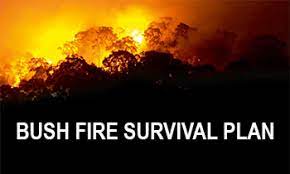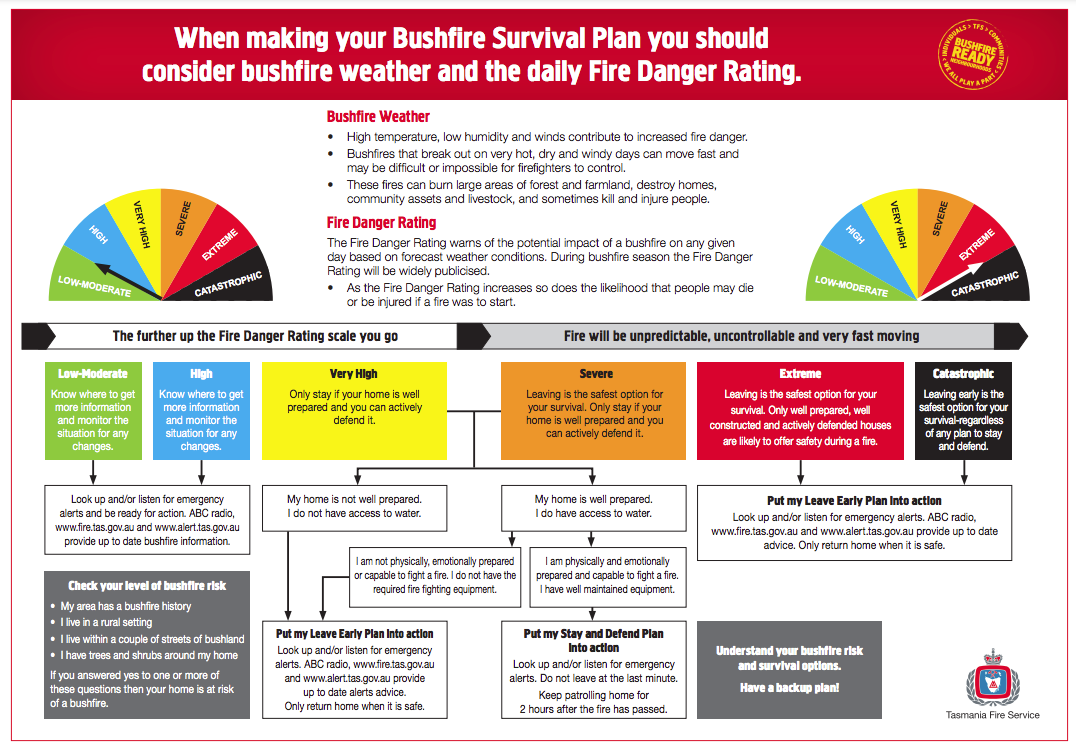
Bush Fire Survival
see resource links below

CHECKLIST PREPARING YOUR SURVIVAL KIT
Prepare a bushfire survival kit before the bushfire season starts. This will help you get through the first few days after a fire. Make sure you have transport and a bushfire survival kit ready regardless of whether you are going to leave or actively defend your house.
GENERAL ITEMS
Portable battery operated AM/FM radio
Waterproof torch (Shaker or battery)
Red or Green Flashing Laser Pointer (Flashing auto on type for signalling search vehicles or at least a single laser pointer)
New spare batteries
First aid kit with manual
Woollen blankets or
Emergency Blanket Space Blanket Silver Foil Blanket First Aid 200x127cm
FOOD AND WATER
Drinking water at least three (3) litres per person per day for four (4) days]
Canned food (dried food is also a good alternative) to last four (4) days
Can opener, cooking gear and eating utensils
A portable gas stove or barbecue
Cigarette Lighter or Stove lighter or Matches
Water container (for washing and cooking water)
ON THE DAY ADD
Cash, key cards and credit cards
Medications, toiletries and sanitary supplies
Special requirements for infants, elderly, injured, those with disabilities and pets
Mobile phone and charger, with Auto car adapter charger or phone card
Emergency contact numbers
Extra car and house keys
Combination pocket knife
Important documents, valuables and photos
Change of clothes for everyone

MIS132 Bushfire Survival Kit.pdf
Around the home if in the bush
STARVE THE FIRE Reduce the fuel loads around your home so that embers will have less chance to start a fire when they hit the ground. This will also help reduce the damage caused by the fire. For at least 20 metres around your home and other buildings:
Cut long grass and dense scrub.
Remove dead material. Remove all rubbish and rake up leaf litter, twigs, bark and material that may catch fire.
Maintain a minimum two metre gap between your house and tree branches. Make sure that no trees overhang the house. Prune lower branches (up to two metres off the ground) to stop a fire on the ground spreading to the canopy of the trees. Do not clump shrubs, ensure that there is a gap. Shrubs should be planted at a distance of at least three times their height at maturity from buildings. Other actions you will need to take:
Keep your gutters free of leaves and other combustible material.
Create a mineral earth firebreak, with no vegetation along your boundary.
Build your paths adjacent to the building and have your driveway placed so that it maximises the protection to the house. If possible, plan your garden so that your vegetable garden, lawn, pool or patio is on the side of the house likely to face a fire (where the bush is).
Store firewood away from the building.
Ensure that your gas bottles are secured and positioned so that it will vent away from the building if it is subject to flame contact or radiant heat.
Ensure fences are non-combustible so they can help to shield your home from a bushfire and radiant heat. FILL THE GAPS Houses usually catch fire when embers get into the roof space, a wall cavity, on to ledges or under the house.
Prevent sparks from entering your house by blocking all the gaps. Block any gaps under floor spaces, in the roof space, under eaves, external vents, skylights, chimneys and wall cladding. Place metal fly wire mesh on all windows, vents and install an ember protection screen on evaporative air conditioners to keep sparks and embers out.
FIX THE FIRE TRAPS Do not pile wood against or near the house. Remove any timber, rubbish and old junk lying around. Move all fuel containers into a shed away from your house and have a firebreak around it. Keep gas cylinders on the side of the house furthest away from the likely direction of a fire (where the bush is).
Ensure the pressure relief valve is directed away from the house. Store gas cylinders upright and secure them with a metal chain to a secure, non-combustible post to prevent cylinders from falling over.
PROTECT YOUR ASSET Have a sufficient independent water supply of at least 20,000 litres and a petrol, diesel or a generator powered pump capable of pumping 400 litres per minute.
Check that your home and contents insurance cover is adequate. Take into consideration renovations, fixtures and additions such as swimming pools, sheds, gazebos, luxury fittings or new appliances.
Prepare your home and property for the bushfire season. It is everyone’s responsibility.
If you live in or near bush take the time to complete and action this checklist.
PREPARE. ACT.
Resources & References
| Click links below title |
|---|
| FACTBOX: How to survive an Australian bush fire |
| https://www.reuters.com/article/us-australia-fires-survival-sb-idUSTRE5181PA20090209 |
https://www.australiangeographic.com.au/explorers/survival-guides/2020/11/bushfire-plan/ |
https://www.withoutahitch.com.au/travel/outback-survival-guide/ |
https://www.redcross.org.au/prepare?gclid=EAIaIQobChMIiNLO07ab8gIVZJNmAh2DyggYEAAYAiAAEgLquPD_BwE |
![]()

Email Peter Faulks

Page last updated 23rd March 2021



















